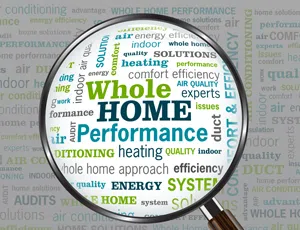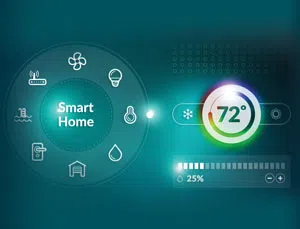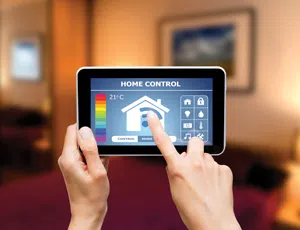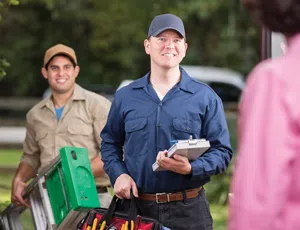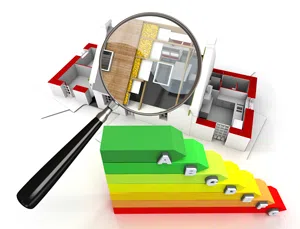Once you have the training and fundamentals in place, home performance can be a lucrative business for your company.
EDITOR'S NOTE: This article originally appeared in Home Energy Magazine.
On one hand, it would seem that for the HVACR contractor, incorporating home performance into his offering would be a natural progression. On the other hand, there are many obstacles to doing so, not least of which is skepticism on the part of many HVACR and home performance contractors. Yet in the long run, there is good reason to believe that for the HVACR contractor, incorporating home performance into his offering is inevitable.
One HVACR contractor who has done so successfully is Jeff Gill, president of Indoor Airman Home Performance in Grants Pass, Ore. When Gill became an HVACR contractor about seven years ago, he immediately saw he needed to include home performance. But that came from his 20 previous years of being a pest management professional.
"We'd go into a home and find the ductwork all chewed up by rats," he said.
That puts Gill in a good position to answer one of the common questions raised by skeptical HVACR contractors: Why would an HVACR contractor want to go back into the customer's home and test the leakiness of the ducts he'd installed? Won't that make the HVACR contractor look bad?
Gill's answer is that if the HVACR contractor doesn't provide this maintenance and the ducts leak, he already looks bad.
"Many of these contractors just don't care," Gill said. "They never check the duct lines."
This leads to another common complaint Gill often gets asked. Why should an HVACR contractor take on insulation and air sealing if he's making enough money now simply swapping mechanical boxes?
"Just swapping boxes is doing the customer a disservice," Gill said. "It's not a question of simple mechanics. If you put in an expensive furnace and the house isn't properly sealed, all you're doing is heating up the outdoors."
Gill's approach, on the other hand, "is to look at the house holistically, not just installing a new heating system or the duct-work, but considering everything from the attic to the understructure." Much of it, Gill said, is common sense, including window and door sealing, weather-stripping, installing insulation, cleaning the coil and blower wheel and so on.
Although the areas of the home that should be checked seem clear, when asked if actually implementing a totally energy efficient home envelope might be a bit complicated, Gill-replies, "Oh, yes, it is complicated! You need special training to really learn how to do home performance."
Gill received training and earned his Building Analyst certification from the Building Performance Institute, Inc. (BPI).
Learning a New Discipline
"Once you get it down, it really works for you," Gill said. "When we show the owner how simple sealing and maintenance measures create a safer and healthier home — such as by cleaning a moldy understructure and increasing IAQ — and how they can reduce energy bills by 20–30 percent, we don't even have to sell a piece of HVACR equipment. We look at homeowners as lifelong customers.
"If you're honest with them, and show them what they need, one step at a time, it's amazing how much they appreciate you. When it comes down to buying a piece of equipment, they'll come right to you, for they trust you that you'll sell them what they need and not oversell just to pocket more of their money. This really brings HVACR up to a new level."
Gill reports that in the years since he left the pest management business, which he and his son ran by themselves, he's grown to 20 employees. For Gill, the training and time it took to become a qualified home performance contractor have been well worth it. "We now have a statewide plan we're going to take national," he said.
The Comfort Institute, which works in cooperation with BPI, is aimed at moving HVACR contractors into home performance. The institute's founder and CEO, Brendan Reid, started (and for many years ran) Retrotec, a blower door manufacturer. But he felt the need to help push the industry toward home performance, so in 1997, he founded the institute.
Ken Summers, who also worked at Retrotec, felt the same need, so he joined Reid in the new venture as vice president. Summers said that, working with BPI, the institute offers business training and leadership programs, as well as sales and marketing skills designed to help HVACR contractors make the transition.
"Our biggest challenge as the industry changes is that too many people don't like change," Summers said. "The issue here is that too many HVACR contractors say, 'I'm fine, I've got my business, I'm satisfied, I don't need to change. It takes a lot of work to change this attitude.'"
On the plus side, Summers said there is now a more concerted push from both EPA and from various state programs. He adds that the institute provides training for dealers on home performance business implementation, building science and sales leads.
Contractor Reluctance
Having witnessed the evolution of home energy from the start, Mike Rogers, former vice president of ABM Energy, in Burlington, Vt., has some insight as to why so many HVACR contractors have been reluctant to jump on the home performance bandwagon, especially when it would seem to make so much business sense.
"Back 10 or 12 years ago, we had to struggle just to get the attention of any residential contractor, period," Rogers said. "There's a tremendous amount of inertia. For the most part, residential contractors tend to be family-owned
businesses. So whatever they do goes right back to them and their families. They are very risk averse and can't afford to just jump into every new idea that comes along. Some of the leaders in this new concept either had a little more luxury or were, in fact, risk takers."
"Home performance is not magic," Rogers adds. "You do have to have your business fundamentals in place to move into this new area or you won't succeed."
But there is another critical reason why HVACR contractors have held back — one that does not necessarily mean that they are negatively closed minded.
"There has been a history of various state agencies and utilities offering incentives to improve home performance, which have turned out to be too risky and uncertain," Rogers said. "These programs have had the tendency to come and go. A contractor would stake his well-being on these programs, and then the provider would come along and pull the rug out.
"The contractor would, in good faith, go to the time and expense of getting his folks trained and certified under program A, and then have the provider say, 'Well, we've changed our mind. We're no longer doing program A, but here's our new program B. This is what you have to do to qualify for program B.' That's not a real compelling argument to make to a contractor who's just seen that his entire investment has been thrown away, while he's been burdened by a tremendous amount of paperwork."
Rogers is quick to point out that programs can be great if they're executed properly.
"But no contractor in his right mind should jump into home performance simply because of a program. Nor should he shy away from it because it is offered in a program. In fact, I've had several leading HVACR contractors in this area tell me that if the programs they are participating in went away tomorrow, they would still be doing home performance.
"If you've gone over all the hurdles, why not leverage your business?" Rogers also asks. "If you find out that meeting your customers' needs for comfort, IAQ, or energy performance doesn't require a furnace, why not have the additional tools at hand to deliver what will make your customer happy? If your only tool is a hammer, every problem looks like a nail."
Rogers also adds that once you've cleared the hurdles of licensing, training, and technical challenges, moving in the whole-home direction makes tons of sense, because you have the most important sales ingredient already in your favor.
"We have some 120 million single and multifamily homes in this country. And all of the utilities, state, and federal agencies have failed to be invited into a single one. But HVACR contractors are invited into an estimated 60,000 to 100,000 homes every single day. The contractor is already there, so he or she can inspect the home and educate the homeowner on much more comprehensive ways to improve the efficiency of their home. He or she can guarantee results, then take control of the entire project to make the house better, as well as increase revenues and profitability margins.
"It's very interesting that over the past few years, with the sagging economy, conventional HVACR contractors have really struggled. Yet while they are sucking wind, just struggling to stay alive, the contractors who have really embraced home performance are growing. The typical mainstream contractor is scratching his head asking why his competitor has 20 trucks on the road while his are sitting in the parking lot. Now that the leaders in the industry are moving in the right direction, I don't think it will be that long before the mass of contractors follow," Rogers said.
Real-World Experiences
GreenHomes America, based in Canonsburg, Pa., is a part of ABM that's dedicated exclusively to helping HVACR contractors make the transition to home performance, said area manager Rayji Powers.
"We have a network of contractors across the United States with revenues ranging from an annual $2 million to $20 million. We provide not just the home performance aspect as an add-on, but rather a full business system, and help them build it as a performance culture. We help them expand their business, and provide everything from installation through the administration process to the generation of energy savings, with all of the qualitative and technical modeling, plus full ongoing support."
Powers also said that GreenHomes works closely with, and serves on the board of, BPI, and has a similar cooperative relationship with ACCA.
Ken Justo, co-owner and CEO of ASI Hastings Heating, Air Conditioning & Solar in San Diego, has high praise for GreenHomes. "When you become BPI certified, that lays the foundation, but it's just the ticket to the game. It doesn't really prepare you to do practical work in the field. Here's where GreenHomes America comes in. The company has been doing it for over 20 years, and has done over 15,000 homes. So it's training is based on real-life experiences. We have more than 2,000 hours of GreenHomes training."
Justo said it took a while; some starts and stops occurred on a steep learning curve, before his company got the proper training and traction took hold. He notes that a lot of contractors have to go through a similar process.
"We've been doing this for about 18 months, but for the first 6 months we had no quality control plan," Justo said. "We had to make nine visits to one home to get the project approved. This is not good for California, where there are a lot of dual family breadwinners, making it necessary for one of them to be at home those nine times. We knew we had to streamline the process, to make it user-friendly."
But this ongoing process of quality improvement can be difficult and expensive.
"Since we are in a private industry, we don't have someone else doing research and development for us," he said. "So we have to do it ourselves to iron out the wrinkles, and this is costly."
Justo also sees problems with the energy savings incentives offered by utility companies and others. "In California, 12 cents is taken out of every home's energy bill for those incentives," he explains. "The person billed doesn't even know what this is for, but it adds up to a considerable sum, which the utilities then offer to homeowners to become more energy efficient. The problem is that many of the implementers and inspection agents who receive the bid to work on behalf of the utilities and get to the homeowners are not very well trained.
"This makes it awkward for the homeowner and difficult for the contractor. And this was a key reason why we had to go back to that one home nine times. They say, here are the guidelines for incentives and customer performance, so then we do our job reporting, and they say it's right. But they've changed the rules in midstream, and say, do it over. It's very costly."
The good news, however, is that both federal and state government agencies are improving. "They are learning, and are at least reaching out and interacting with the contractor, listening to what he has to say. Both the federal and state governments are very sincere in fashioning programs that work. The attitude is great in this state. The goal is to reduce greenhouse emission levels to what they were in 1990 by 2020," Justo said.
"But the best part," he said, is people's reactions when we deliver on our three main goals of air quality, comfort, and energy savings. Especially when they see the health results, they are ecstatic. The American Lung Association said the worst air pollution problems often occur in people's own homes. So when homeowners tell you they or their children no longer have asthma or are off medications, you know that you are really changing lives."
Brad Bartholomew, president of Bartholomew Heating & Cooling, Kalamazoo, Mich., reports that his family-owned business was started in 1955, with the transition from HVACR into home performance starting in about 2003.
"It's been a constant evolution, one that's continuing to evolve," he said. "With an existing company, it's like a ship, difficult to change course. The bigger the company, the more difficult."
Bartholomew said that for his midsized 15-employee company, "there were a lot of cultural issues. We had to have a buy-in all across the company, from the person who answers the phone to the field technicians to the sales staff. We had to both encourage the change in attitude and enforce it. But once people really understood the concept, it made ultimate good sense, and the changes are now implemented."
One issue that comes to the fore, Bartholomew continues, "is that a new piece of HVACR equipment can mean more profit than an energy savings measure, which might come down to common sense. This was not a big issue with us. In some companies there is the pressure to make the sale, but even before, we'd try to sell the customer only what he needs. If he might have needed a new furnace in two or three years, we would have told him that, and not tried to push for the sale right away. We had a much more limited toolbox then. But it is true that putting in HVACR equipment or new windows is down on the list of things that need to be done."
Nevertheless, the incorporation of energy savings into the business has helped the bottom line. "Home performance has really eliminated the peaks and valleys. Up here it's cold in the winter and hot in the summer, with moderate spring and fall. We've ended seasonal slowdowns, and haven't laid off anybody in nine or 10 years. Once you get known as a problem solver, you find it's a huge business builder."
Moreover, between the old and new there's been no real change in philosophy. "We've always believed that getting a customer is more important than making a sale, that if you do the right thing it somehow works out," Bartholomew said. "As my grandfather used to say, 'It's never wrong to do the right thing.'"
Need for Education
"We've been HVACR contractors for 50 years. This is what we do. A few years ago I started reading in the trade magazines about fixing the envelope of the home, and the company has grown from there," said Jerry Unruh, president of ABC Cooling & Heating in Fresno, Calif., "First the boxes, then the ductwork, then home energy. There's still a lot of education that needs to be done with contractors. The more I travel and the more I speak, the more I hear contractors say, 'Wow, this really makes sense. But we'll wait until tomorrow.' But things have changed. Tomorrow is today, and we all have to go green."
Unruh reaffirms the similar points made by those quoted above, but he adds a couple of telling details. The first is that "there are 33,000 BPI-certified people, but only 10 percent of them are doing any work in this area. So the industry still has a lot of maturing to do."
The second fact that Unruh mentions is that someone simply going into homes to do free audits doesn't necessarily translate into home improvements. "We found in one city, the residents were provided with 3,000 free audits, and not one took advantage of any of the incentives or made any energy improvements."
In other words, homeowners don't have a tendency to do it themselves. And this is the opportunity for the contractor. Contractors can finance a package that bundles the whole thing together, and then they become the one person the homeowner can hold responsible.
"What we do when we audit takes about three hours to do in a full assessment. We then are able to provide a priority list, telling the homeowner just what he needs to do to save so much, and let him proceed in terms of his own inclinations and budget. Once he's sold on the concept of the holistic home, he's likely to want to make his home one," Unruh said.
To leave the final word to Mike Rogers: "In looking at regional electrical generation capacities, the needs, over the next five years, will be huge. There are not enough facilities, so more will have to be built, and no one wants them in their backyard. To tap into the real potential to meet this need, experts agree efficiency has to be a serious part of the mix. But we have to look beyond changing lightbulbs to probing much deeper to improve every home. We're about to enter the perfect storm, and have no good option but to accelerate the growth of home performance."
Thomas Dolan is a business journalist based in the Pacific Northwest. For additional information and articles on home performance, visit homeenergy.org.

